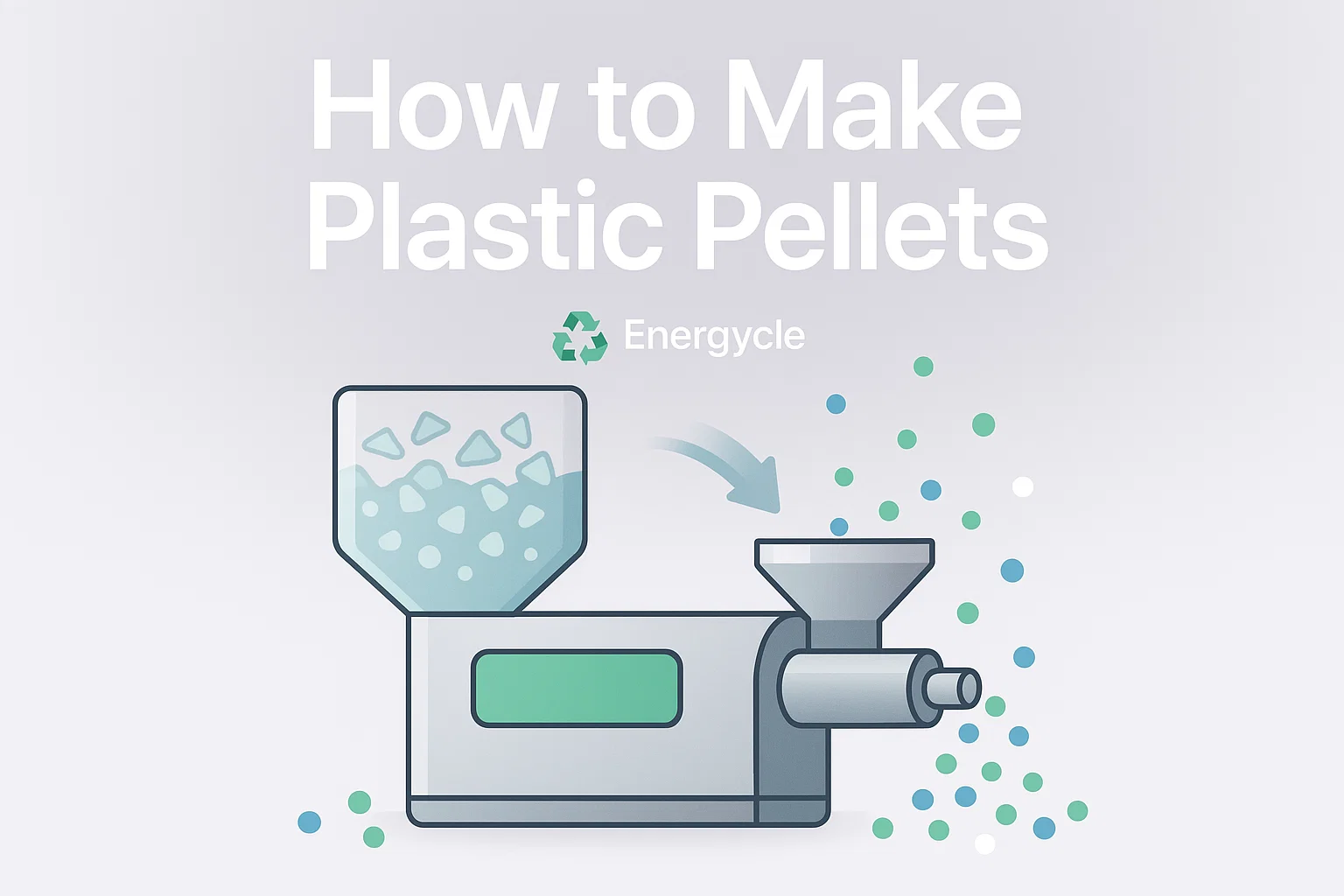Plastic pellets are the foundation of countless products, from packaging to automotive components. For industrial recycling equipment buyers and professionals, understanding how to make plastic pellets efficiently is key to optimizing operations and contributing to a sustainable future. At Energycle: Plastic Recycling Machinery, we specialize in delivering state-of-the-art plastic pelletizing systems designed to transform plastic waste into high-quality pellets. This guide explores the plastic pelletizing process, offering insights into equipment, techniques, and best practices to ensure top-tier results.
What Are Plastic Pellets?
Plastic pellets, also known as nurdles, are small, uniform granules of plastic used as raw material in manufacturing. These pellets are created through a process called pelletizing, where plastic waste or virgin resin is melted, shaped, and cut into consistent sizes. Pellets are versatile, easy to transport, and ideal for injection molding, extrusion, and other production methods.
For recycling professionals, producing high-quality pellets means maximizing material value while minimizing environmental impact. A robust plastic pelletizing system is essential for achieving this balance.
The Importance of Plastic Pelletizing in Recycling
Pelletizing is a cornerstone of plastic recycling, enabling businesses to convert post-consumer and post-industrial plastic waste into reusable material. This process reduces landfill waste, conserves resources, and supports the circular economy. By investing in advanced plastic pelletizing systems, companies can enhance efficiency, reduce costs, and meet stringent industry standards.
At Energycle, our plastic pelletizing solutions are engineered to handle diverse plastic types, including LDPE, HDPE, PP, and PET, ensuring consistent output and minimal downtime.
The Plastic Pelletizing Process: Step-by-Step
Creating plastic pellets involves several stages, each requiring precision and reliable equipment. Below, we outline the key steps in the pelletizing process, highlighting how Energycle’s plastic pelletizing systems streamline operations.
1. Material Collection and Sorting
The process begins with collecting plastic waste, which may include scraps, offcuts, or post-consumer items like bottles and films. Sorting is critical to ensure material purity, as different plastics (e.g., PET, PP) have unique melting points and properties. Advanced sorting technologies, such as optical sorters or manual inspection, remove contaminants like metals, paper, or incompatible plastics.
omschrijving: Use automated sorting systems to improve accuracy and reduce labour costs. Energycle’s solutions integrate seamlessly with sorting equipment for a streamlined workflow.
2. Shredding and Size Reduction
Once sorted, plastic waste is fed into a shredder or granulator to reduce it into smaller, manageable flakes. Uniform flake size ensures consistent melting in later stages. High-capacity shredders, like those offered by Energycle, are designed for durability and can handle tough materials without clogging.
3. Washing and Drying
Contaminants such as dirt, labels, or adhesives must be removed to produce high-quality pellets. The washing process involves soaking, agitating, and rinsing the plastic flakes in specialized washing lines. After washing, drying systems remove moisture to prevent defects during pelletizing.
Energycle’s washing and drying systems are optimized for energy efficiency, ensuring clean, dry flakes are ready for processing. Learn more about our equipment at plasticpelletizer.net.
4. Extrusion and Melting
The clean, dry flakes are fed into an extruder, where they are heated and melted into a molten plastic stream. The extruder’s screw design and temperature controls are critical for maintaining material consistency. Energycle’s plastic pelletizing systems feature advanced extruders with precise temperature regulation, ensuring optimal melt quality for various plastic types.
5. Filtration
To remove any remaining impurities, such as micro-contaminants or degraded polymers, the molten plastic passes through a filtration system. Screen changers or melt filters trap debris, ensuring the final pellets are pure and uniform. Continuous filtration systems, like those in Energycle’s portfolio, minimize downtime and maintain production efficiency.
6. Pelletizing
The filtered molten plastic is extruded through a die plate, forming thin strands or “spaghetti-like” streams. These strands are then cut into pellets using one of two primary methods:
- Strand Pelletizing: The plastic strands are cooled in a water bath or air stream before being cut into pellets by a rotating blade. This method is ideal for materials requiring precise pellet size.
- Underwater Pelletizing: The molten plastic is extruded directly into a water chamber, where a rotating cutter slices it into pellets. This method is suited for high-throughput operations.
Energycle’s plastic pelletizing systems offer both strand and underwater pelletizing options, tailored to your production needs.
7. Cooling and Drying
After cutting, the pellets are cooled to solidify their shape. In underwater pelletizing, pellets are cooled in the water chamber, while strand pelletizing may use air or water cooling. Post-cooling, pellets are dried to remove residual moisture, ensuring they are ready for storage or further processing.
8. Classification and Packaging
The final step involves classifying pellets by size and quality using vibrating screens or classifiers. Consistent pellet size is crucial for downstream applications like injection molding. Once classified, pellets are packaged in bags, silos, or containers for transport or sale.
Plastic Pelletizing Workflow
Below is a simplified diagram illustrating the plastic pelletizing process:
[Plastic Waste] → [Sorting] → [Shredding] → [Washing & Drying] → [Extrusion & Melting] → [Filtration] → [Pelletizing] → [Cooling & Drying] → [Classification & Packaging]For a visual representation of how Energycle’s plastic pelletizing systems integrate these stages, visit plasticpelletizer.net.
Key Equipment for Plastic Pelletizing
A high-performance plastic pelletizing system relies on robust equipment tailored to your production goals. Key components include:
- Shredders and Granulators: For size reduction of plastic waste.
- Washing Lines: To clean and prepare flakes.
- Extruders: For melting and shaping plastic.
- Filtration Systems: To ensure pellet purity.
- Pelletizers: For cutting strands into uniform pellets.
- Cooling and Drying Units: To finalize pellet formation.
Energycle’s plastic pelletizing systems are designed for scalability, energy efficiency, and low maintenance, making them ideal for industrial recycling operations.
Performance Comparison: Strand vs. Underwater Pelletizing
Choosing the right pelletizing method depends on your material type and production goals. Below is a comparison of strand and underwater pelletizing:
| Feature | Strand Pelletizing | Underwater Pelletizing |
|---|---|---|
| Material Suitability | Best for low-viscosity plastics (e.g., PP, PE) | Ideal for high-viscosity plastics (e.g., PET) |
| Pellet Uniformity | High, with precise cutting | Very high, with spherical pellets |
| Throughput | Moderate to high | High, suited for large-scale operations |
| Onderhoud | Simpler, fewer Simpler, fewer moving parts | More complex, requires water management |
| Energie-efficiëntie | matig | Higher due to water cooling systems |
Raadpleeg onze voor gedetailleerde specificaties plastic pelletizing systemsOntdek ons assortiment plasticpelletizer.net.
Best practices voor het optimaliseren van de productie van kunststofdeeltjes
Houd rekening met de volgende aanbevelingen voor maximale efficientie en korrelkwaliteit:
- Investeren in hoogwaardige apparatuurSelecteer een plastic pelletizing system Met geavanceerde automatisering en duurzaamheid, zoals Energycle, om downtime en onderhoudskosten te verminderen.
- Een consistente input van materiaal: de juiste sortering en reiniging voorkomen vervuiling en zorgen voor uniforme deeltjes.
- Controle van de extrusieparameters: temperatuur en de snelheid aan te passen in de kunststof schroef, voor optimale kwaliteit smelt.
- Regelmatig onderhoudRegelingen voor de extruder, filters en een coating van routine-inspecties van productie te voorkomen.
- Deeltjes kwaliteit testenPeriodieke analyse van de grootte van de deeltjes, vormen en zuiverheid, om tegemoet te komen aan de eisen van de klant.
Waarom kiezen voor Energycle voor plastic granuleren?
Bij Energycle begrijpen we de behoefte aan industriele recycling. onze plastic pelletizing systems Ontworpen voor precisie, efficientie en duurzaamheid. Met tientallen jaren van expertise, wij bieden oplossingen op maat, om te voldoen aan uw specifieke behoeften, van klein tot de voorzieningen. Ons systeem dat wordt ondersteund door een uitgebreide ondersteuning en geavanceerde technologie, zorgt ervoor dat u in de milieueffecten van de hoogste kwaliteit, met de kleinste deeltjes.
Ontdek het volledige gamma van uitrusting in alfabetische volgorde in de plasticpelletizer.net Verbetering van de recycling van vandaag.
Conclusion
Het produceren van plastic deeltjes is een belangrijk proces om plastic afval om te zetten in waardevolle grondstoffen. Door gebruik te maken van de geavanceerde plastic pelletizing systemsRecyclingprofessionals kunnen hoogwaardige, consistente korrels verkrijgen terwijl ze de duurzaamheidsdoelstellingen ondersteunen. Bij Energycle zijn we toegewijd aan het leveren van innovatieve, betrouwbare oplossingen om uw pelletisering te vereenvoudigen. bezoek plasticpelletizer.net Ontdek hoe wij u kunnen helpen om succesvol te zijn in de recyclingindustrie.

